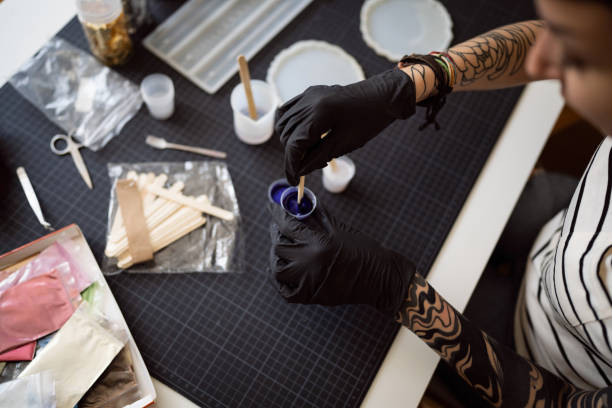
Step-by-Step Guide to Making Resin Coasters at Home in Singapore
Creating your own resin coasters is a fun and creative way to explore the world of DIY crafts. With the rise in popularity of resin coaster DIY kits in Singapore, it has never been easier for beginners and hobbyists alike to dive into this vibrant, hands-on art form. Whether you’re decorating your home or planning a personalized gift, resin coasters offer endless possibilities.
This guide will walk you through everything you need to know from what’s in a typical kit to curing your final masterpiece.
What Is a Resin Coaster DIY Kit?
A resin coaster DIY kit typically includes all the essential materials to create decorative coasters using epoxy resin. These kits are curated for beginners and seasoned crafters alike. In Singapore, many kits cater to local environmental conditions, such as humidity, which can affect resin curing.
Most kits include:
- Epoxy resin and hardener
- Silicone coaster molds
- Mixing cups and stirrers
- Gloves and protective gear
- Color pigments or mica powders
- Decorative elements like dried flowers or gold foil
You can also find eco-friendly resin options and UV-resistant formulas in Singapore-based shops or online platforms.
Why Are Resin Coaster Kits Popular in Singapore?
Crafting at home has gained popularity, especially in urban environments like Singapore, where people seek mindful and creative outlets. Resin art fits that need perfectly. With limited space and a warm climate, coasters are a practical, small-scale craft project that suits local conditions well.
Other reasons for their popularity include:
- Easy to start with minimal investment
- Personalization options for gifting
- Aesthetic appeal for home decor
- Workshops and communities available locally
You can also explore resin art through weekend craft markets, pop-up stores, or local workshops in Singapore.
Step 1: Prepare Your Workspace
Before diving into resin mixing, it’s essential to set up a clean and ventilated workspace. Resin emits fumes while curing, so choose a well-ventilated room or use a fan for airflow.
Things to prepare:
- Disposable table cover or plastic sheet
- Nitrile gloves and an apron
- A level surface to prevent uneven curing
- Masking tape to seal mold edges (optional)
Keep children and pets away during the process, as liquid resin can be toxic if touched or inhaled.
Step 2: Measure and Mix the Resin
Accurate mixing is critical. Epoxy resin usually comes in a 1:1 or 2:1 ratio, so refer to the instructions in your DIY kit.
Steps to follow:
- Pour equal amounts of resin and hardener into a mixing cup.
- Stir slowly for 3–5 minutes, scraping the sides to avoid bubbles.
- Transfer into a second cup and stir again (double-cup method) for even consistency.
Avoid fast stirring as it introduces air bubbles, which may ruin the finish of your coaster.
Step 3: Add Color and Decorative Elements
Now comes the fun part customizing your design. Use mica powders, alcohol inks, or resin-safe dyes to color your resin. If your kit includes dried flowers or metallic flakes, now is the time to incorporate them.
Tips for better results:
- Add small amounts of pigment to avoid oversaturation.
- Use a toothpick or stick to swirl colors for a marble effect.
- Layer materials to create depth.
In Singapore’s warm climate, resin cures a bit faster, so work quickly but carefully.
Step 4: Pour the Resin into Molds
Once your mixture is ready, slowly pour the resin into the silicone molds included in your kit.
Important tips:
- Pour in a circular motion to reduce bubbles.
- Fill up to 90–95% to prevent overflow.
- Use a heat gun or lighter to remove surface bubbles (briefly and carefully).
Leave the molds undisturbed in a dust-free area to cure. Covering them with a plastic container can help prevent dust or insects from settling.
Step 5: Let It Cure
Curing time varies based on temperature and humidity, both of which are relevant in Singapore. Most epoxy resins require 24–72 hours to fully cure.
Best practices during curing:
- Avoid moving the molds.
- Keep the temperature steady (preferably above 22°C).
- Do not touch the surface for at least 12 hours.
Once fully cured, the coasters should be hard, glossy, and slightly flexible before unmolding.
Step 6: Unmold and Finish
Carefully remove the cured coasters from the silicone mold. If the edges are rough, you can sand them gently with fine-grit sandpaper. Optional finishing touches include:
- Adding a felt or cork backing
- Sealing with a topcoat for extra gloss
- Polishing with a microfiber cloth
Make sure the coasters are fully dry before using or packaging them.
Safety Tips When Using Resin in Singapore
Because of Singapore’s tropical climate, always store resin in a cool, dry place. High humidity can affect curing, making resin cloudy or sticky.
Additional safety tips:
- Always wear gloves and safety glasses.
- Work in a ventilated area.
- Never pour leftover resin down the sink.
Dispose of materials responsibly, and follow local environmental guidelines where possible.
Where to Buy Resin Coaster DIY Kits in Singapore
Resin coaster DIY kits are widely available across Singapore. You can find them through:
- Local craft stores in shopping malls
- Online platforms like Shopee, Lazada, and Carousell
- Art fairs and weekend creative workshops
Look for beginner-friendly kits that include detailed instructions, especially if you’re just starting out.
Frequently Asked Questions (FAQ)
1. Can I use regular resin for coasters?
Yes, but make sure it’s heat-resistant epoxy resin to prevent warping when exposed to hot drinks.
2. Do I need to use a mold release spray?
Most silicone molds don’t require it, but a release spray can extend mold life and help with easy unmolding.
3. How do I store leftover resin?
Store resin and hardener in a cool, dark place with tightly sealed lids. Keep away from sunlight and humidity.
4. Is resin crafting safe for children?
Resin is not recommended for young children due to chemical exposure. Always supervise older teens and follow safety instructions.
5. Why is my resin not curing properly?
This could be due to inaccurate mixing, high humidity, or old resin. Always follow the mixing ratios and store your materials properly.
Final Thoughts
Resin coaster DIY kits are a fantastic way to get creative at home in Singapore. With the right tools, a safe workspace, and a bit of patience, anyone can craft beautiful and functional coasters. Whether you’re gifting them or using them in your home, these little art pieces reflect your personality and effort.
So if you’re in Singapore and looking for your next DIY project, a resin coaster kit might just be the perfect place to start.






